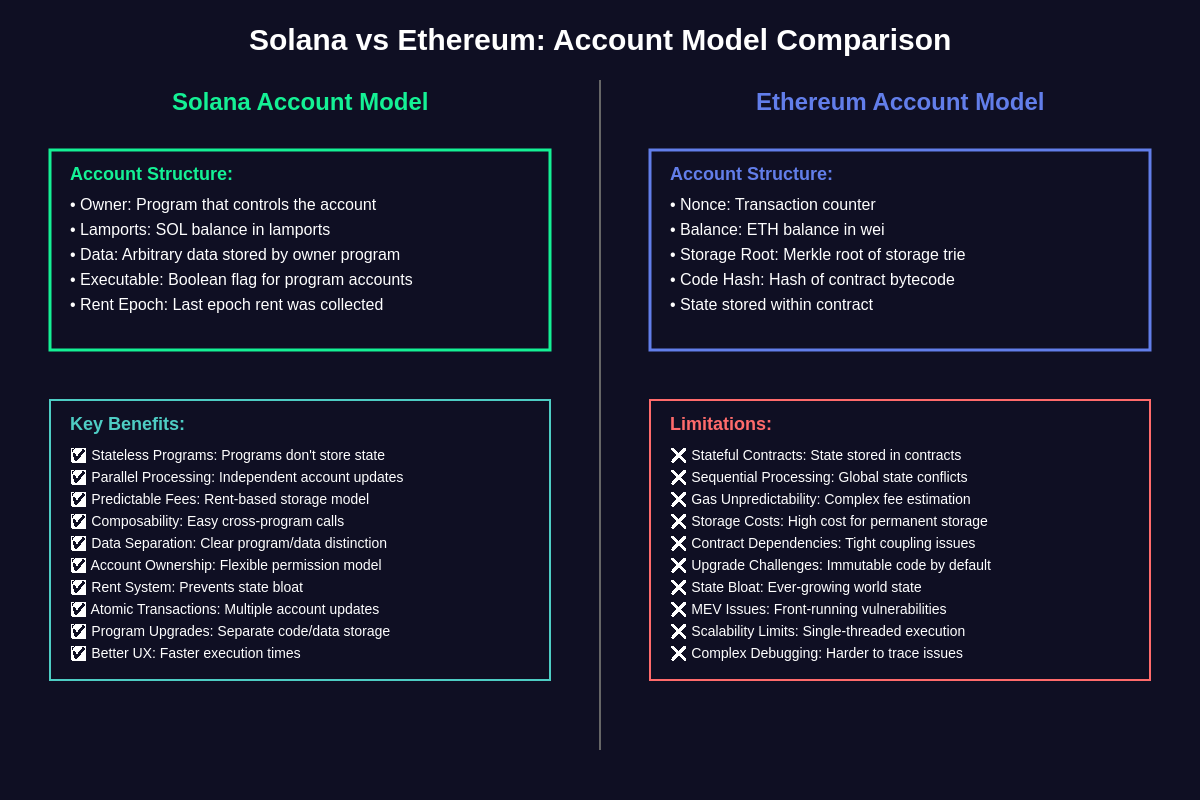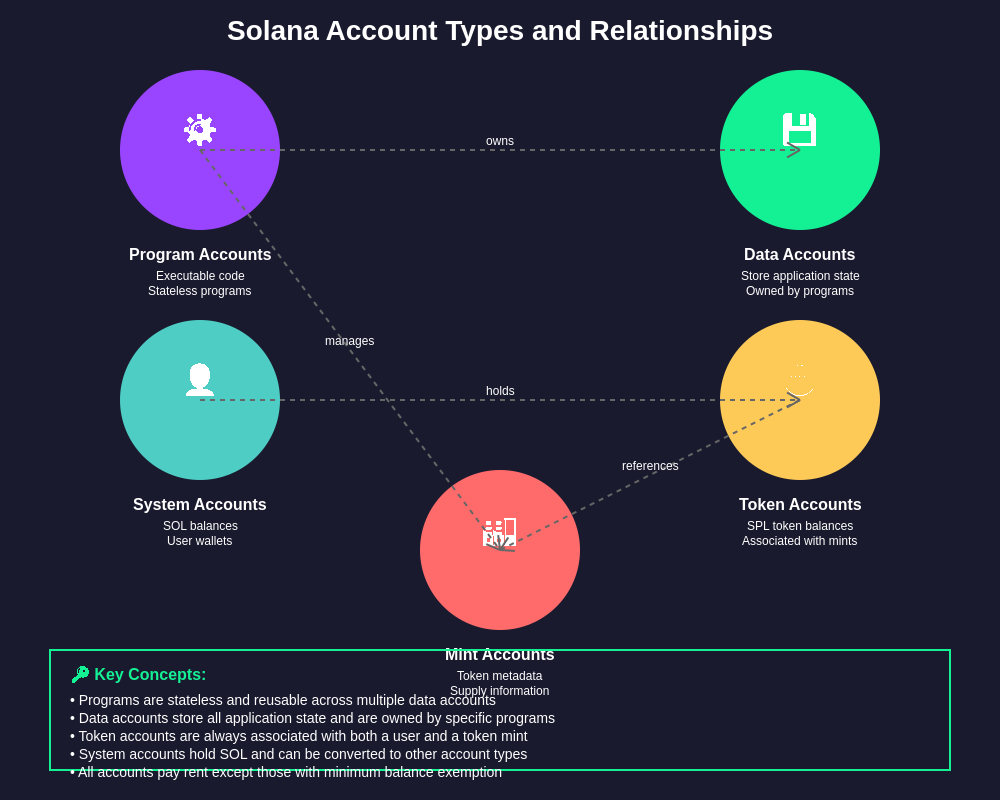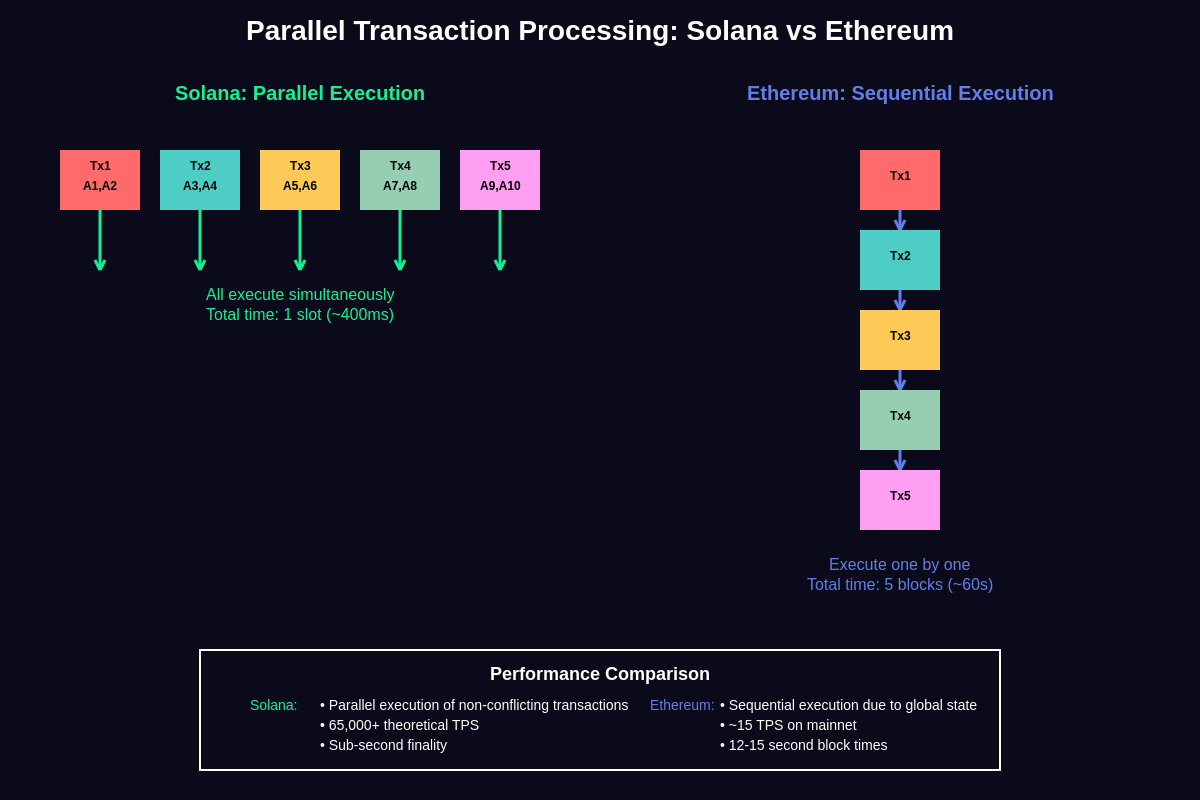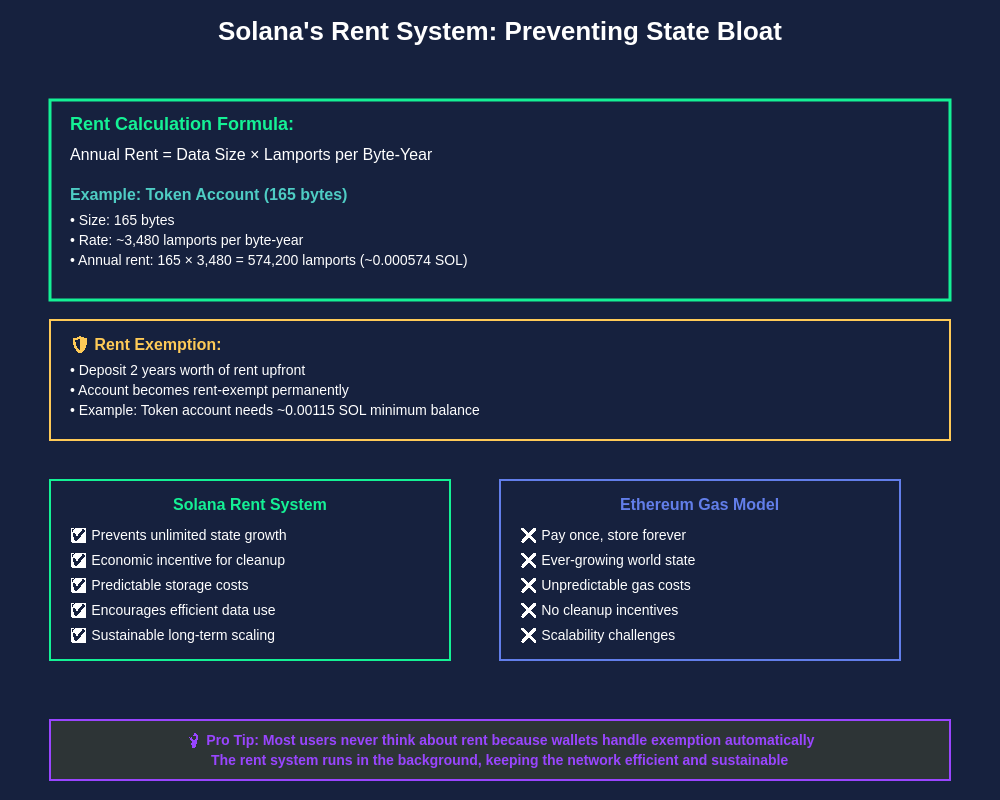The Fundamental Architecture Revolution
Solana’s account model represents a paradigm shift in blockchain architecture that addresses many of the scalability and efficiency limitations inherent in Ethereum’s design. While both networks enable smart contract functionality and decentralized applications, their underlying approaches to data storage, transaction processing, and state management differ dramatically, with Solana’s price reflecting growing recognition of these architectural advantages among developers and institutions.
The distinction between these two models extends far beyond mere technical implementation details, fundamentally affecting how applications are built, how transactions are processed, and how the networks scale to accommodate growing demand. Solana’s account-based architecture enables parallel transaction processing, predictable fee structures, and improved composability between applications, while Ethereum’s account model, though pioneering in its introduction of smart contracts, faces inherent limitations that impact scalability and user experience.
Understanding these architectural differences is crucial for developers choosing platforms for their applications, investors evaluating long-term network prospects, and users seeking to understand why certain operations behave differently across these major blockchain platforms. The implications of these design choices ripple through every aspect of the user experience, from transaction confirmation times to application development complexity.
Ethereum’s Account Model: The Foundation and Its Limitations

Ethereum introduced the revolutionary concept of smart contracts through an account-based system that distinguishes between two types of accounts: externally owned accounts controlled by private keys and contract accounts containing executable code. This model stores both account balances and contract state within the same framework, creating a unified but inherently sequential processing environment that has defined how most developers think about blockchain applications.
The Ethereum Virtual Machine processes transactions sequentially, maintaining a global state that must be updated atomically with each block. This approach ensures consistency and prevents double-spending, but creates significant bottlenecks when multiple transactions attempt to modify related state variables. The gas system, while innovative in preventing infinite loops and spam, adds complexity to fee estimation and can result in unpredictable transaction costs during network congestion.
Contract accounts in Ethereum store both their executable code and their state data together, creating tight coupling between application logic and data storage. This design choice simplifies certain aspects of development but limits flexibility in upgrading contracts, sharing state between applications, and optimizing storage costs. The storage model requires developers to pay gas for every state change, with costs varying based on network demand rather than actual resource consumption.
The sequential nature of Ethereum’s transaction processing means that even independent operations must wait for previous transactions to complete, creating artificial dependencies that limit throughput. This limitation becomes particularly pronounced during periods of high network activity, when simple token transfers can take minutes to confirm and cost tens of dollars in fees, highlighting the scalability challenges inherent in the architectural design.
Solana’s Revolutionary Account Architecture

Solana fundamentally reimagines blockchain architecture by separating executable programs from the data they operate on, creating a stateless programming model that enables unprecedented parallel processing capabilities. Programs in Solana are immutable and stateless, storing no data themselves but instead operating on separate data accounts that they own and control, creating a clean separation of concerns that enables multiple transactions to execute simultaneously without conflicts.
This separation allows Solana’s runtime to analyze transactions before execution, identifying which accounts each transaction will access and determining which transactions can be processed in parallel without interfering with each other. The result is a system capable of processing thousands of transactions simultaneously across multiple processor cores, rather than the sequential processing that characterizes most blockchain networks including Ethereum.
The account ownership model provides fine-grained control over data access and modification rights, with each account having a designated owner program that controls how the account’s data can be modified. This creates a security model where programs can only modify accounts they own, preventing unauthorized access while enabling complex multi-program interactions through well-defined interfaces and cross-program invocations.
Solana’s rent system ensures network sustainability by requiring accounts to maintain minimum balances to cover storage costs, preventing the unlimited state growth that plagues many blockchain networks. Accounts can become rent-exempt by depositing enough SOL to cover two years of rent, after which they remain permanently stored without ongoing costs, providing predictable storage economics for developers and users.
Parallel Processing: The Ultimate Scalability Advantage

The most significant advantage of Solana’s account model lies in its ability to process non-conflicting transactions in parallel, fundamentally changing the performance characteristics of blockchain applications. While Ethereum processes approximately 15 transactions per second sequentially, Solana can theoretically process over 65,000 transactions per second by utilizing multiple processor cores simultaneously, with historical data showing consistent high-throughput performance in real-world conditions.
This parallel processing capability stems from Solana’s ability to determine transaction dependencies before execution, allowing the runtime to schedule independent transactions across multiple execution threads. For example, if one transaction modifies accounts A and B while another modifies accounts C and D, both can execute simultaneously since they don’t share any common accounts, dramatically improving overall network throughput.
The implications for application design are transformative, as developers can build applications that would be prohibitively expensive or slow on sequential processing networks. High-frequency trading applications, gaming platforms with numerous simultaneous players, and social media applications with real-time interactions become economically viable on Solana due to the combination of parallel processing and low transaction costs.
This architectural advantage compounds over time, as network utilization increases. While Ethereum experiences congestion and exponentially rising fees during high demand periods, Solana’s parallel processing capability allows it to maintain consistent performance and low fees even as transaction volume grows, providing a more predictable and scalable foundation for decentralized applications.
State Management and Data Architecture Superiority
Solana’s approach to state management represents a fundamental improvement over Ethereum’s monolithic world state, providing developers with more flexible and efficient ways to structure application data. Rather than storing all state within smart contracts, Solana applications create dedicated data accounts for different aspects of their functionality, enabling better organization, more efficient access patterns, and improved composability between applications.
The separation of program logic from program data creates opportunities for optimization that are impossible in Ethereum’s model. Programs can be upgraded or replaced without affecting existing data, data can be shared between multiple programs with appropriate permissions, and developers can optimize data layouts for specific use cases without being constrained by the virtual machine’s storage model.
This architecture enables more sophisticated data management strategies, such as creating hierarchical data structures, implementing efficient indexing systems, and designing data schemas that minimize storage costs and access times. Developers can create data accounts that are optimized for specific access patterns, whether that’s frequent small updates, large batch operations, or complex queries across multiple related data points.
The rent system provides additional flexibility by allowing developers to choose between different storage strategies based on their application’s needs. Temporary data can be stored in accounts that eventually expire if not maintained, while permanent data can be made rent-exempt through appropriate balance management, giving developers fine-grained control over storage economics and lifecycle management.
Transaction Fees and Economic Predictability

One of the most user-facing advantages of Solana’s account model is the dramatically more predictable and affordable fee structure compared to Ethereum’s volatile gas market. While Ethereum users face unpredictable costs that can range from a few dollars to hundreds of dollars for complex transactions, Solana maintains consistent sub-penny transaction fees regardless of network congestion, enabling new categories of applications that require frequent interactions.
The rent-based storage model provides transparent and predictable costs for data storage, allowing developers to calculate exact storage costs in advance and design applications with known economic parameters. This predictability enables the creation of applications that would be economically unfeasible on networks with volatile fee structures, such as micro-payment systems, frequent automated transactions, and interactive applications that require numerous small transactions.
The economic model also creates better incentive alignment between users and network infrastructure. Rather than competing in fee auctions during congestion periods, users pay consistent fees for consistent service levels, while the rent system ensures that network resources are used efficiently and compensated fairly over time.
This fee predictability extends to complex operations involving multiple accounts and cross-program calls, where Ethereum’s gas model can create surprising cost escalations. Solana’s fee structure remains linear and predictable even for complex operations, enabling developers to provide better user experiences and more accurate cost estimates for their applications.
Developer Experience and Application Architecture
The architectural differences between Solana and Ethereum create vastly different developer experiences, with Solana’s model enabling more modular, reusable, and efficient application designs. The separation of programs and data encourages developers to think about application architecture in terms of reusable components and shared infrastructure, rather than monolithic contracts that duplicate functionality across the ecosystem.
Solana’s account model enables more sophisticated application architectures, such as plugin systems where different programs can extend core functionality, shared data layers that multiple applications can build upon, and modular designs that allow for incremental upgrades and feature additions. This modularity reduces development time, improves code reuse, and creates opportunities for collaboration between different development teams.
The stateless program model also simplifies testing and debugging, as programs are pure functions that operate on explicit input accounts rather than hidden global state. This makes it easier to reason about program behavior, create comprehensive test suites, and identify the root causes of issues when they occur, improving overall development productivity and application reliability.
Cross-program invocations in Solana are more explicit and controlled than inter-contract calls in Ethereum, providing better security guarantees and more predictable behavior. Developers can design complex multi-program interactions with confidence that the behavior will be consistent and secure, enabling the creation of sophisticated decentralized applications that leverage multiple specialized programs.
Security Model and Permission Management
Solana’s account ownership model provides more granular and flexible security controls compared to Ethereum’s contract-based permissions. Each account has a clear owner that controls modification rights, creating a security model that’s easier to reason about and audit. This clear ownership hierarchy prevents many classes of vulnerabilities that can occur in Ethereum’s more complex permission systems.
The separation of programs and data also creates security advantages by limiting the scope of potential vulnerabilities. Since programs are stateless and immutable, many categories of bugs that affect Ethereum contracts, such as state corruption or unexpected interactions between different contract functions, simply cannot occur in Solana’s model.
The explicit account specification required for Solana transactions provides additional security benefits by making it clear exactly which accounts a transaction will access. This transparency enables better security analysis, more effective monitoring systems, and clearer audit trails for complex operations involving multiple accounts and programs.
Access control patterns in Solana can be more sophisticated and efficient than Ethereum’s approaches, with the ability to create fine-grained permissions, delegation systems, and role-based access controls that operate efficiently at the protocol level rather than requiring expensive on-chain computation for every permission check.
Composability and Ecosystem Integration
The architectural advantages of Solana’s account model create superior composability between different applications and protocols within the ecosystem. Programs can be designed to work together more seamlessly, with shared data accounts enabling applications to build upon each other’s functionality without requiring complex integration patterns or expensive cross-contract calls.
This composability extends to token standards, where Solana’s SPL token standard operates more efficiently than Ethereum’s ERC-20 implementation. Token accounts are first-class citizens in Solana’s architecture, enabling more efficient transfers, better integration with DeFi protocols, and lower costs for token-based applications. The associated token account model eliminates many of the approval mechanisms required in Ethereum, simplifying user interactions and reducing transaction costs.
The ability to create shared infrastructure accounts that multiple applications can utilize enables the development of more efficient and cost-effective ecosystem services. Price oracles, governance systems, and other shared utilities can be implemented as dedicated programs with shared data accounts, reducing duplication and enabling more sophisticated ecosystem-wide functionality.
Integration patterns that are expensive or complex in Ethereum become straightforward in Solana’s model, enabling developers to create applications that naturally work together and share resources efficiently. This architectural advantage has enabled Solana’s DeFi ecosystem to achieve higher capital efficiency and better user experiences compared to similar applications on other networks.
Performance Benchmarks and Real-World Impact
Real-world performance data demonstrates the practical advantages of Solana’s account model, with the network consistently processing hundreds of transactions per second while maintaining sub-second confirmation times and minimal fees. During peak usage periods when Ethereum experiences severe congestion and fee spikes, Solana maintains consistent performance characteristics, providing users with reliable service regardless of network demand.
The performance advantages translate directly into user experience improvements, with applications on Solana providing near-instant confirmations and minimal friction for user interactions. This enables entirely new categories of applications that require real-time interactions, such as on-chain gaming, high-frequency trading, and social media platforms with blockchain-based features.
Transaction throughput comparisons show Solana processing thousands of times more transactions than Ethereum while maintaining orders of magnitude lower costs per transaction. These advantages compound when considering complex applications that require multiple transactions, where the efficiency gains become even more pronounced and enable entirely different approaches to application design.
The consistent performance characteristics also enable better user experience predictability, as developers can design applications with confidence that performance will remain consistent as usage scales. This reliability is crucial for enterprise applications and consumer-facing services that require dependable performance characteristics.
Future Implications and Network Evolution
The architectural advantages of Solana’s account model position the network well for future evolution and scaling improvements. The parallel processing foundation provides a scalable base that can take advantage of hardware improvements and optimization techniques that are not available to sequential processing networks.
The modular design of programs and data accounts creates opportunities for future optimizations, such as state compression techniques, more efficient data structures, and specialized hardware acceleration for common operations. These improvements can be implemented without requiring fundamental changes to existing applications, preserving investment in current development while enabling future performance gains.
As the blockchain industry matures and requirements for scalability, efficiency, and user experience become more demanding, the architectural advantages of Solana’s approach become increasingly valuable. The network’s design principles align with the long-term trends toward more efficient, user-friendly, and scalable blockchain infrastructure.
The growing recognition of these advantages is reflected in increasing developer adoption, expanding ecosystem development, and growing institutional interest in Solana-based applications. As more developers experience the benefits of Solana’s account model, the network effects and ecosystem advantages are likely to compound over time.
Economic Impact and Market Recognition
The practical advantages of Solana’s account model have translated into significant economic value creation, with the network hosting billions in total value locked across various DeFi protocols and applications. The efficiency advantages enable applications to achieve better unit economics, higher user engagement, and more sustainable business models compared to alternatives built on less efficient architectures.
Market recognition of these technical advantages has contributed to Solana’s position among the top blockchain networks by market capitalization and developer activity. The network’s performance during various market cycles demonstrates the resilience and practical value of its architectural choices, with market analysis frequently highlighting the technical superiority as a key factor in long-term value propositions.
The cost savings enabled by Solana’s efficient architecture translate directly into better user experiences and more accessible applications. Users can interact with sophisticated DeFi protocols, gaming applications, and other services without the prohibitive costs that characterize similar activities on other networks, democratizing access to blockchain-based services.
These economic advantages create positive feedback loops that attract more developers, users, and capital to the ecosystem, reinforcing the network effects that make Solana an increasingly attractive platform for new application development and existing application migration.
Conclusion: A Superior Foundation for Decentralized Applications
Solana’s account model represents a fundamental advancement in blockchain architecture that addresses the key limitations of earlier designs while maintaining the security and decentralization principles that make blockchain technology valuable. The separation of programs and data, parallel processing capabilities, predictable fee structure, and superior developer experience create a platform that is better suited for the demanding requirements of modern decentralized applications.
The architectural advantages translate into practical benefits for every stakeholder in the ecosystem: developers can build more sophisticated applications more efficiently, users enjoy better performance and lower costs, and the network can scale to accommodate growing demand without sacrificing decentralization or security. These benefits compound over time as the ecosystem grows and matures.
As blockchain technology continues to evolve from experimental protocols toward mainstream infrastructure, the importance of efficient, scalable, and user-friendly architectures becomes increasingly apparent. Solana’s account model provides a blueprint for how blockchain networks can be designed to meet the performance requirements of global-scale applications while maintaining the fundamental properties that make blockchain technology transformative.
The growing adoption of Solana by developers, enterprises, and users validates the practical advantages of this architectural approach and suggests that the account model superiority will continue to drive ecosystem growth and innovation. For anyone building on or evaluating blockchain platforms, understanding these architectural differences and their implications is crucial for making informed decisions about the future of decentralized technology.
Disclaimer
This article is for informational and educational purposes only and should not be construed as financial advice. Cryptocurrency investments carry significant risks, including the potential for total loss of capital. The volatile nature of cryptocurrency markets means that prices can fluctuate dramatically in short periods. Past performance does not guarantee future results, and you should conduct thorough research and consider your risk tolerance before making any investment decisions. The technical analysis and market commentary presented here represent opinions and observations that may not prove accurate. Always consult with qualified financial advisors and conduct your own due diligence before making investment decisions. The cryptocurrency market is largely unregulated in many jurisdictions, and regulatory changes could significantly impact market conditions and individual cryptocurrency values.